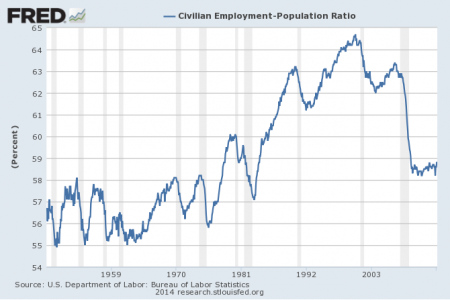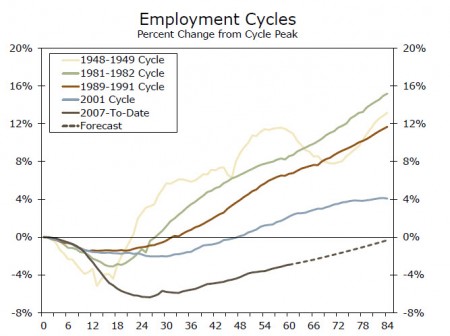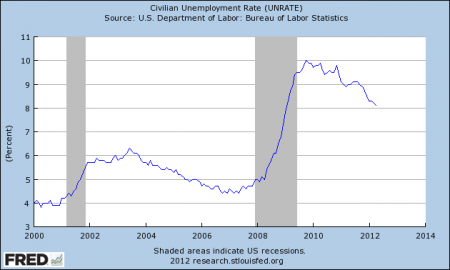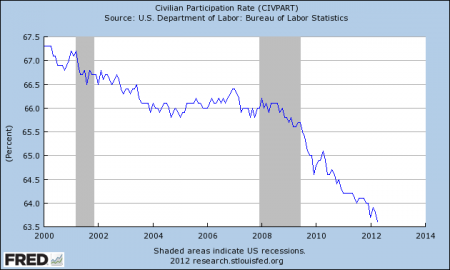Home » labor market
Category Archives: labor market
Still the same
Official unemployment rate has gone down dramatically, but the improvement of labor market has been largely fake, as the employment-population ratio hasn’t moved much since recession ended. See this sharp chart from John Taylor at Stanford.
You can also take a longer term perspective at this ratio below:
Feel puzzled? You can find out the reason why unemployment rate and the employment-population ratio tend to diverge during this reovery here.
US Labor market update
At tepid pace in monthly employment gains, this labor market recovery has been similar to the recovery after 2001 recession, if not much worse. Two charts to put the current labor market condition in comparative perspective – another “jobless recovery”.
(graph courtesy of Wells Fargo Economics)
(graph courtesy of Northern Trust)
Why still no robust employment recovery?
Gary Becker summarizes the reasons for the slow job recovery into three categories:
1. The aftermath of a big financial crisis, as explained by the research done by Reinhart and Rogoff;
2. Policy and regulation uncertainties hinder investment, although Corporate America are flooded with cash;
3. Relatively more generous unemployment benefits offer no immediate incentives for job seeking, keeping a non-negligible proportion of population out of labor force.
(graph courtesy of Calculated Risk)
The unemployment puzzle
The official unemployment rate has been dropping:
Yet, employment to population ratio shows nothing has really improved:
So what to believe? Is US labor market thawing? Or are we still in a slump?
The official unemployment rate is calculated as the number of unemployed divided by labor force. Let’s use an example to illustrate. An economy has a total labor force of 100; if 10 is unemployed, then the unemployment rate is 10/100=10%.
To understand the issue, we need to appreciate how the labor force is calculated. If 3 out of 10 people who are previously unemployed drop out of labor force, because they are discouraged by not being able to find a job for quite some time, labor force now changes from 100 to 97. And the new unemployment rate is (10-3)/(100-3)=7/97=7.2%. This represents a 2.8% improvement, although the labor market condition has not improved at all.
Is this what’s happening now in the US? If so, it will show up in labor participation rate, which is defined as the ratio between total labor force and adult population. And let’s assume the adult population is 150. When there are discouraged workers giving up and exiting the labor market, labor participation rate drops from 100/150=67% to 97/150=65%.
Not surprisingly, that is what we see in the real data:
A Cheer for Obama’s Corporate Tax Break
Reports WSJ:
President Barack Obama, in one of his most dramatic gestures to business, will propose that companies be allowed to more quickly write off 100% of their new investment in plants and equipment through 2011.
The proposal, to be laid out Wednesday in a speech in Cleveland, tops a raft of announcements, from a proposed expansion of the research and experimentation tax credit to $50 billion in additional spending on roads, railways and runways.
Companies can now deduct new investment expenses, but over a longer period of time—three to 20 years. The proposed change, which would let companies keep more cash now, is meant to give companies who may be hesitant to invest an incentive to expand, acting as a spur to the overall economy.
Although the timing of the announcement looks suspicious (see the video interview below), let’s genuinely hope this will increase business confidence and hiring.










